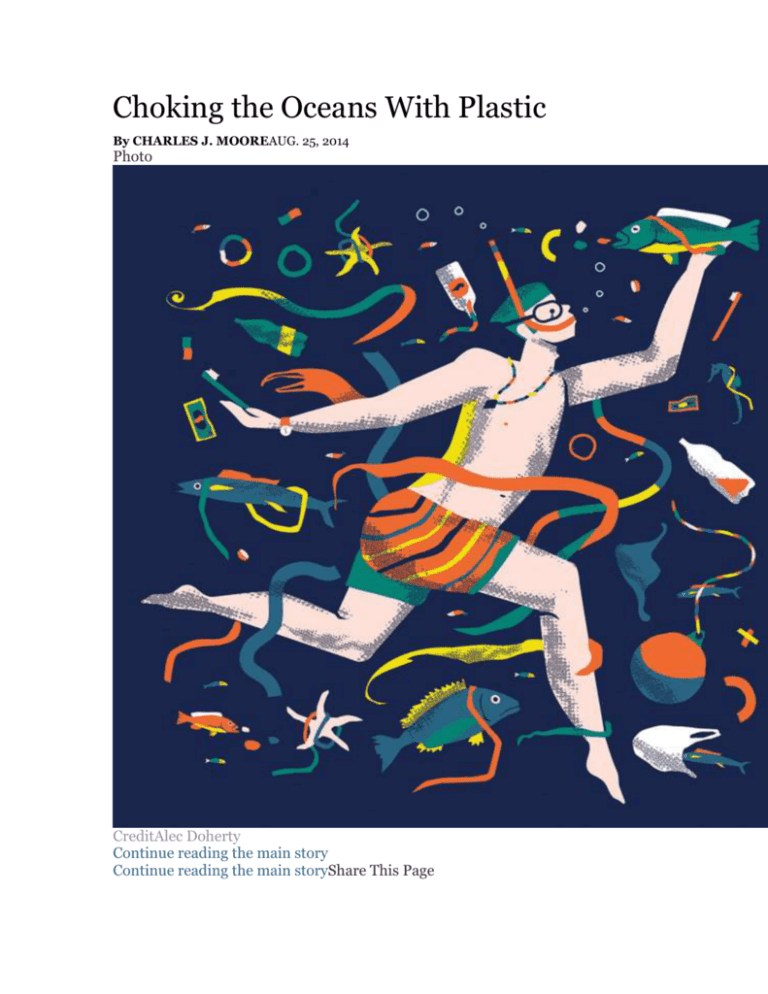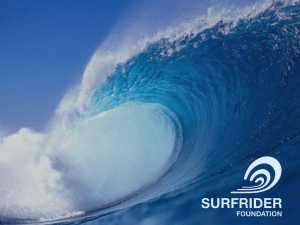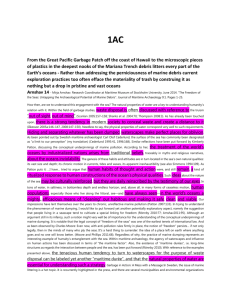marine fragments
advertisement

Choking the Oceans With Plastic By CHARLES J. MOOREAUG. 25, 2014 Photo CreditAlec Doherty Continue reading the main story Continue reading the main storyShare This Page Email Share Tweet Save More Continue reading the main story LOS ANGELES — The world is awash in plastic. It’s in our cars and our carpets, we wrap it around the food we eat and virtually every other product we consume; it has become a key lubricant of globalization — but it’s choking our future in ways that most of us are barely aware. I have just returned with a team of scientists from six weeks at sea conducting research in the Great Pacific Garbage Patch — one of five major garbage patches drifting in the oceans north and south of the Equator at the latitude of our great terrestrial deserts. Although it was my 10th voyage to the area, I was utterly shocked to see the enormous increase in the quantity of plastic waste since my last trip in 2009. Plastics of every description, from toothbrushes to tires to unidentifiable fragments too numerous to count floated past our marine research vessel Alguita for hundreds of miles without end. We even came upon a floating island bolstered by dozens of plastic buoys used in oyster aquaculture that had solid areas you could walk on. Plastics are now one of the most common pollutants of ocean waters worldwide. Pushed by winds, tides and currents, plastic particles form with other debris into large swirling glutinous accumulation zones, known to oceanographers as gyres, which comprise as much as 40 percent of the planet’s ocean surface — roughly 25 percent of the entire earth. No scientist, environmentalist, entrepreneur, national or international government agency has yet been able to establish a comprehensive way of recycling the plastic trash that covers our land and inevitably blows and washes down to the sea. In a 2010 study of the Los Angeles and San Gabriel Rivers, my colleagues and I estimated that some 2.3 billion pieces of plastic — from polystyrene foam to tiny fragments and pellets — had flowed from Southern California’s urban centers into its coastal waters in just three days of sampling. The deleterious consequences of humanity’s “plastic footprint” are many, some known and some yet to be discovered. We know that plastics biodegrade exceptionally slowly, breaking into tiny fragments in a centuries-long process. We know that plastic debris entangles and slowly kills millions of sea creatures; that hundreds of species mistake plastics for their natural food, ingesting toxicants that cause liver and stomach abnormalities in fish and birds, often choking them to death. We know that one of the main bait fish in the ocean, the lantern fish, eats copious quantities of plastic fragments, threatening their future as a nutritious food source to the tuna, salmon, and other pelagic fish we consume, adding to the increasing amount of synthetic chemicals unknown before 1950 that we now carry in our bodies. We suspect that more animals are killed by vagrant plastic waste than by even climate change — a hypothesis that needs to be seriously tested. During our most recent voyage, we studied the effects of pollution, taking blood and liver samples from fish as we searched for invasive species and plasticlinked pollutants that cause protein and hormone abnormalities. While we hope our studies will yield important contributions to scientific knowledge, they address but a small part of a broader issue. The reality is that only by preventing synthetic debris — most of which is disposable plastic — from getting into the ocean in the first place will a measurable reduction in the ocean’s plastic load be accomplished. Clean-up schemes are legion, but have never been put into practice in the garbage patches. The National Oceanic and Atmospheric Administration in the United States supports environmentalist groups that remove debris from beaches. But the sieve-like skimmers they use, no matter how technologically sophisticated, will never be able to clean up remote garbage gyres: There’s too much turbulent ocean dispersing and mixing up the mess. The problem is compounded by the aquaculture industry, which uses enormous amounts of plastic in its floats, nets, lines and tubes. The most common floats and tubes I’ve found in the deep ocean and on Hawaiian beaches come from huge sea-urchin and oyster farms like the one that created the oyster-buoy island we discovered. Those buoys were torn from their moorings by the tsunami that walloped Japan on March 11, 2011. But no regulatory remedies exist to deal with tons of plastic equipment lost accidentally and in storms. Government and industry organizations purporting to certify sustainably farmed seafood, despite their dozens of pages of standards, fail to mention gear that is lost and floats away. Governments, which are rightly concerned with depletion of marine food sources, should ensure that plastic from cages, buoys and other equipment used for aquaculture does not escape into the waters. But, in the end, the real challenge is to combat an economic model that thrives on wasteful products and packaging, and leaves the associated problem of clean-up costs. Changing the way we produce and consume plastics is a challenge greater than reining in our production of carbon dioxide. Plastics are a nightmare to recycle. They are very hard to clean. They can melt at low temperatures, so impurities are not vaporized. It makes no difference whether a synthetic polymer like polyethylene is derived from petroleum or plants; it is still a persistent pollutant. Biodegradable plastics exist, but manufacturers are quick to point out that marine degradable does not mean “marine disposable.” Scientists in Britain and the Netherlands have proposed to cut plastic pollution by the institution of a “circular economy.” The basic concept is that products must be designed with endof-life recovery in mind. They propose a precycling premium to provide incentives to eliminate the possibility that a product will become waste. In the United States, especially in California, the focus has been on so-called structural controls, such as covering gutters and catch basins with screens. This has reduced the amount of debris flowing down rivers to the sea. Activists around the world are lobbying for bans on the most polluting plastics — the bottles, bags and containers that deliver food and drink. Many have been successful. In California, nearly 100 municipalities have passed ordinances banning throwaway plastic bags and the Senate is considering a statewide ban. Until we shut off the flow of plastic to the sea, the newest global threat to our Anthropocene age will only get worse. Charles J. Moore is a captain in the U.S. merchant marine and founder of the Algalita Marine Research and Education Institute in Long Beach, California. A version of this op-ed appears in print on August 26, 2014, on page A23 of the New York edition with the headline: Choking the Oceans With Plastic. Order Reprints|Today's Paper|Subscribe







